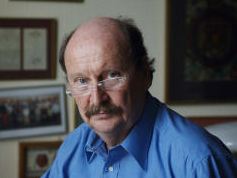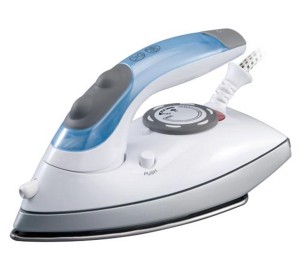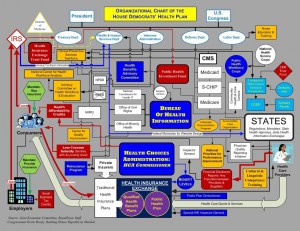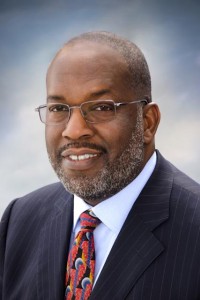October 25th, 2012 by admin in Opinion
1 Comment »

Photograph: Roger Bamber
How far do we travel from our parents’ patterns? A question psychotherapists and their clients have been wrestling with for decades.
We can’t escape the parental imprint. Some of us may not want to. But those of us who did hope to be different often find ourselves in our 40s or 50s unexpectedly leaking parental behaviors or attitudes we thought we had purged ourselves of in our 20s.
I sometimes hear myself saying to Richard, my partner, as he heads out the door for his Tae Kwon Do class, “Be careful.” He has a second degree black belt and has been studying for years. He is always careful. My admonition is a spillover of my father’s anxious voice warning me to be on the lookout for endless, unnamed dangers hiding in plain sight at every turn. Other times I see myself tighten up like a fist when something I thought I had control over twists in an unpredictable direction. It is not my jaw that clenches in agitation; it is my mother’s jaw, on my face.
How our parents do or did illness is a powerful pattern. Did they suffer in silence, while allowing no one to offer tenderness or help? Did they submerge into illness and allow it to define who they were? Did they use illness to control and manipulate? To get attention? Did they remain engaged in living and loving? Did they learn from illness to become more fully who they were? Did they become nastier to each other? Or sweeter? And finally, did they take care of each other — physically and emotionally?
My parents, who kept each other at a distance when well, became even more separated when ill. They went so far as to resent each other for their increasing incapacities. It was not pretty.
There were times when I was in the thick of my pain condition, that I isolated and withdrew from Richard. But more often, I allowed my pain to teach me to reach out for comfort and connection. I had to. For me, the voice of pain was more powerful than my parents’ example.
Dealing with illness can be a consuming job. When you find yourself behaving in ways that don’t create the kind of bridge to your partner that will help lighten the load for both of you, pause and ask yourself: “Am I playing out a pattern that doesn’t really belong to me? Whose voice am I speaking with? Can I do it differently?”
How did your parents deal with illness? What did you learn to do and not to do from them?
***
Barbara Kivowitz is a psychotherapist, business consultant, and book author. She blogs regularly at In Sickness And In Health.
October 24th, 2012 by admin in Health Tips, Quackery Exposed
No Comments »

Edzard Ernst, M.D., Ph.D.
Cancer patients are understandably desperate to try every treatment that promises a cure. They often turn to the Internet where they find thousands of “alternative” cancer cures being sold often for exorbitant cost. One of them is Ukrain.
Ukrain is based on two natural substances: alkaloids from the Greater Celandine and Thiotepa. It was developed by Dr Wassil Nowicky who allegedly cured his brother’s testicular cancer with his invention. Despite its high cost of about £50 per injection, Ukrain has become popular in the UK and elsewhere.
Ukrain has its name from the fact that the brothers Nowicky originate from the Ukraine, where also much of the research on this drug was conducted. When I say much, I should stress that I use this word in relative terms. In the realm of “alternative” cancer cures, we often find no clinical studies at all. For Ukrain, however, the situation is refreshingly different; there are a number of trials, and the question is, what do they really tell us?
In 2005, we decided to review all the clinical studies which had tested the efficacy of Ukrain. Somewhat to our surprise, we found 7 randomised clinical trials. Even more surprising, we thought, was the fact that all of them reported baffling cure rates. So, were we excited to have identified a cure for even the most incurable cancers? The short answer to this question is NO.
All of the trials were methodologically weak; but, as this is not uncommon in the area of alternative medicine, it did not irritate us all that much. Far more remarkable was the fact that these studies seemed to be odd in several other ways.
Their results seemed too good to be true; all but one trial came from the Ukraine where research governance might have been less than adequate. The authors of the studies seemed to overlap and often included Nowicky himself. They were published in only two different journals of little impact. The only non-Ukrainian trial came from Germany and was not much better: its lead author happened to be the editor of the journal where it was published; more importantly, the paper lacked crucial methodological details, which rendered the findings difficult to interpret, and the trial had a tiny sample size.
Collectively, these circumstances were enough for us to be very cautious. Consequently, we stated that “numerous caveats prevent a positive conclusion”.
Despite our caution, this article became much cited, and cancer centres around the world began to wonder whether they should take Ukrain more seriously; many integrative cancer clinics even started using the drug in their clinical routine. Dr Nowicky, who meanwhile had established his base in Vienna from where he marketed his drug, must have been delighted.
Soon, numerous websites sprang up praising Ukrain: “It is the first medicament in the world that accumulates in the cores of cancer cells very quickly after administration and kills only cancer cells while leaving healthy cells undamaged. Its inventor and patent holder Dr Wassil Nowicky was nominated for the Nobel Prize for this medicament in 2005…” .
Somehow, I doubt this thing with the Nobel Prize. What I do not question for a minute, however, is this press release by the Austrian police: since January, the Viennese police have been investigating Dr Nowicky. During a “major raid” on 4 September 2012, he and his accomplices were arrested under the suspicion of commercial fraud. Nowicky was accused of illegally producing and selling the unlicensed drug Ukrain. The financial damage was estimated to be in the region of 5 million Euros.
I fear, however, that the damage done on desperate cancer patients across the world might be much greater. Generally speaking, “alternative” cancer cures are not just a menace, they are a contradiction in terms: there is no such a thing and there will never be one. If tomorrow this or that alternative remedy shows some promise as a cancer cure, it will be investigated by mainstream oncology with some urgency; and if the findings turn out to be positive, the eventual result would be a new cancer treatment. To assume that oncologists might ignore a promising treatment simply because it originates from the realm of alternative medicine is idiotic and supposes that oncologists are mean bastards who do not care about their patients – and this, of course, is an accusation which one might rather direct towards the irresponsible purveyors of “alternative” cancer cures.
***
Dr. Ernst is a PM&R specialist and the author of 48 books and more than 1000 articles in the peer-reviewed medical literature. His most recent book, Trick or Treatment? Alternative Medicine on Trial is available from amazon. He blogs regularly at EdzardErnst.com and contributes occasionally to this blog.
October 22nd, 2012 by admin in Health Tips
1 Comment »
 Some of you may find this surprising, but I don’t mind ironing. Unlike giving a lecture, writing a column or appearing on TV or radio, you get immediate gratification. You see the results of your efforts. Wrinkles that were there before are gone. I suspect, however, that not everyone shares my enthusiasm for this task. The textile industry realizes this as well and has responded by producing a variety of “durable press” fabrics that can withstand wrinkles. But withstanding allegations of toxicity is more of a challenge. In this case the hullabaloo is about formaldehyde, the chemical used to fashion garments that can come straight out of the washing machine and sidestep the ironing board.
Some of you may find this surprising, but I don’t mind ironing. Unlike giving a lecture, writing a column or appearing on TV or radio, you get immediate gratification. You see the results of your efforts. Wrinkles that were there before are gone. I suspect, however, that not everyone shares my enthusiasm for this task. The textile industry realizes this as well and has responded by producing a variety of “durable press” fabrics that can withstand wrinkles. But withstanding allegations of toxicity is more of a challenge. In this case the hullabaloo is about formaldehyde, the chemical used to fashion garments that can come straight out of the washing machine and sidestep the ironing board.
Wrinkling is a direct consequence of the molecular structure of cellulose, the main component of cotton. This polymer is made up of repeating units of glucose, but the important feature of cellulose, as far as wrinkling is concerned, is that adjacent molecules can form weak associations with each other. These “hydrogen bonds” are responsible for maintaining the shape of the fabric. But when cotton is moistened, water molecules insert themselves between the long chains of cellulose, cleaving the hydrogen bonds. The cellulose molecules can now move relative to each other, and as the fabric dries and the water molecules evaporate, the hydrogen bonds reform holding the fabric in its new shape, which is usually wrinkled. Another factor in wrinkling is the thickness of the cotton fibers. Fabric woven with very fine cotton thread will crease less than fabric made with more coarse thread.
Heat can also disrupt hydrogen bonds, which explains how ironing works. The weight of the iron flattens the fabric and the novel shape is then retained as the material cools. Ironing with steam is especially effective because the added water molecules serve as an internal lubricant, breaking hydrogen bonds and allowing cellulose molecules to slide past each other. As heat is applied, the water evaporates, hydrogen bonds reform, and we have a smoothened fabric. At least until it gets moist from perspiration.
The earliest attempts to reduce wrinkling made use of starch, possibly as early as 800 BC. Like cellulose, starch is made of repeating units of glucose, and the two substances have an affinity for each other. A starch solution readily penetrates into cotton fibers and when the fabric dries the molecules of starch bind to each other forming a hard network, stiffening the fiber. An analogy would be a canvas water hose that can be easily folded when empty, but becomes stiff when filled with water. The problem with starch, though, is that it comes out in the wash and has to be applied each time.
The early part of the twentieth century saw the introduction of a number of synthetic resins such as urea-formaldehyde which presented textile manufacturers with an opportunity to “stuff” fibers with a substance that would not wash out as readily as starch. It worked reasonably well, but when the chemical structure of cellulose became clarified in the late twenties, chemists came up with another idea. Given that wrinkling is caused by the movement of the cellulose molecules relative to each other, why not find a way to form bonds between cellulose molecules that are not as easily disrupted by moisture as hydrogen bonds?
Formaldehyde was just the molecule for this task. It readily reacts with the hydroxyl groups on cellulose to form cross-links, much like the rungs of a ladder. The idea is to form the fabric into the desired shape and then treat it with formaldehyde to retain that shape. Manchester textile manufacturer Tootal Broadhurst Lee was the first company to use this process commercially back in the 1930s, producing the world’s first “wrinkle-free” garment, the “Tootal” tie. But it wasn’t long before a wrinkle appeared in the novel technology. The garments released the irritating odour of formaldehyde. Not only was this smell unpleasant, but formaldehyde was also responsible for the allergic contact dermatitis reactions that emerged with the use of the durable press fabrics. Later there would be increased concern about formaldehyde treatments as studies began to show that at least in animals the chemical was a carcinogen.
By the 1990s significant improvement had been made in technology to reduce formaldehyde release from treated fabrics. During manufacture the fabric was subjected to huge rollers that squeezed out excess formaldehyde followed by heat treatment in an oven to cure the formaldehyde and prevent it from being released. Another method that requires less formaldehyde, known as “vapour phase technology,” involves hanging moistened clothing in an airtight chamber and treating it with a gaseous mixture of formaldehyde and sulphur dioxide to form the required cross-links.
A number of other cross-linking agents have also been introduced, with the most widely used ones being dimethyloldihydroxyethyleneurea (DMDHEU) and ethylene-urea/melamine-formaldehyde (EUMF). While effective at producing wrinkle-free fabrics, they, like formaldehyde, can still cause allergic reactions. Exposure to permanent-press fabrics should always be considered as a possible cause of dermatitis that has no obvious trigger.
Although the amount of formaldehyde released from permanent press fabrics is unlikely to affect health except for rare cases of allergic dermatitis, manufacturers have made determined efforts to reduce formaldehyde exposure. The textile industry uses a “Sealed Jar Test” to measure the amount of formaldehyde released from one gram of fabric under controlled conditions. Since the early days of durable press, the amount released has been decreased by a factor of ten. Cross-linking agents that do not release formaldehyde at all, such as dimethylurea glyoxal (DMUG), have also been developed but they cost more and do not perform quite as well.
The advent in the 1960s of polyester fabrics with a greatly reduced tendency to wrinkle took some of the pressure off producing wrinkle-resistant cotton fabrics. But since not everyone likes the feel of polyester, even when blended with cotton, the prospect of producing a truly permanent-press cotton fabric still looms in front of manufacturers’ eyes. They’re getting there though. Recently I bought some shirts that barely need the touch of an iron. And as far as formaldehyde exposure from such fabrics goes, well, I think there are far bigger wrinkles in the fabric of life to worry about.
***
Joe Schwarcz, Ph.D., is the Director of McGill University’s Office for Science and Society and teaches a variety of courses in McGill’s Chemistry Department and in the Faculty of Medicine with emphasis on health issues, including aspects of “Alternative Medicine”. He is well known for his informative and entertaining public lectures on topics ranging from the chemistry of love to the science of aging. Using stage magic to make scientific points is one of his specialties.
October 15th, 2012 by Dr. Val Jones in Health Policy, Health Tips, True Stories
5 Comments »
 From a health perspective, I am grateful to be doing well. I have only one active medical condition that is fully treated by one prescription medicine. I have been taking this medicine since I was 18 years old. I recently bought myself a personal health insurance plan (my first that was not tied to employment) and simply wanted to resume regular purchase and use of my medicine.
From a health perspective, I am grateful to be doing well. I have only one active medical condition that is fully treated by one prescription medicine. I have been taking this medicine since I was 18 years old. I recently bought myself a personal health insurance plan (my first that was not tied to employment) and simply wanted to resume regular purchase and use of my medicine.
I was pleased to note that purchasing my medicine through the new insurance plan would save me a little bit of money (about $25/month). So I presented my card at the local pharmacy and was told that my medicine was not covered under my plan without pre-authorization from my doctor. I called my pharmacy benefits hotline and had them send a pre-auth form to my doctor. Then I asked him to fill out the form and fax it back. That was over three months ago.
When I called to inquire about the pre-auth forms, the benefits folks told me that they had no record of the fax. So I asked my doctor to send another fax form and I waited another week. When I called the benefits people, they again said that they had no record of the pre-auth documentation. They also said that I could not be transferred to the pre-auth team to figure out why it was missing (wrong fax number perhaps?) because they only speak to providers.
So out of curiosity I asked what the usual process was for obtaining a prescription medication once it has been authorized. The benefits staff didn’t know. I asked who would know and they said that only the “experts” in the pre-auth department know how medications are obtained by the member after being approved. I wondered how I’d ever figure this out if I wasn’t allowed to speak to them and I was told that I might be able to get an answer if I asked a customer care representative to request information on my behalf from the pre-auth experts. But… the pre-auth team was not in the office at the moment and I’d need to call back on Monday. (Parenthetically, the team is physically located in Pittsburgh, Pennsylvania, though I’m a member in Charleston, South Carolina.)
I asked the benefits team if they generally mail members their meds (I had heard this was the case) or if I could pick them up at my local pharmacy (my preference). They said they didn’t know, but I could call customer care on Monday.
So far, my experience with my new plan – to save $25 dollars/month on one prescription – has cost me 3 months and 1 week of waiting time, two form completion episodes with my doctor, discussions with several pharmacy benefits reps in a state far away from where I live, denial of communication with the only people who know what’s potentially holding up my prescription approval, and about a half hour of completely unhelpful discussion of basic prescription drug purchasing processes that staff at the drug benefits company themselves don’t understand.
And I’m healthy, I’m a healthcare provider who knows how to navigate the system, and I only need one prescription. What do sick people do? (I know, it’s awful out there.)
Life was much simpler when I paid for my medication out-of-pocket without an insurance middle man. I have often wondered if health insurance bureaucracy is purposefully designed to wear patients down to the point where they’ll just pay for things themselves rather than experience the pain associated with getting an insurance company to cover their portion of the cost. (The only other explanation is that health insurance company ineptitude comes from being administrative behemoths with too many moving parts and processes). It’s probably a mix of the two. Or maybe the latter supports the former so there’s no real incentive to pursue true efficiency.
But one thing I did notice – the insurance company was incredibly efficient at figuring out how to direct debit my premiums within 24 hours of signing up for the plan, and have increased my premium once already – by about $25 a month.
You can’t win, my friends.
If you’re healthy, get yourself a high deductible plan, pay as little in premiums as possible, and sock away some money in case of a catastrophic event. Pay cash for your primary care, and do whatever you can to stay healthy and out of the hospital. That’s my plan and I’m sticking to it.
***
Update: My medicine was finally approved/authorized, but I was informed that my doctor would need to send a new Rx form to them before I could receive my prescription. The Rx needed to be on their company’s form, so they had to fax him the request first. I asked how I would pay for the prescription and where I could pick it up and was informed that I’d save about 15% if I agreed to have the medicine mailed to my home (but delivery would take 2 extra weeks).
So I agreed to have it mailed to my home and offered to give them my credit card. They said I should call back with it once my doctor’s Rx had been received. I asked them how I would know when that had occurred. They said that they couldn’t call me to tell me when the Rx had arrived because I had selected “text messaging” as my preferred method of contact, and they don’t inform members of Rx form receipt via text messaging. So I agreed to switch my preference to calls (instead of text), and now I’ll probably get automated prescription refill information in the form of incoming calls on my personal work phone from now till I die. That’s if they don’t sell my phone number to telemarketers in the mean time.
And how annoying is it for my doctor to have sent out two faxes and one new Rx form for ONE prescription (not to mention reading the email explanations from me regarding correct pharmacy benefits plan form usage)? He was uncompensated for his time in this matter…
October 12th, 2012 by admin in Health Tips
No Comments »
 As fathers, one of our most important responsibilities is to be there for our children. Work and travel schedules may make it difficult to be home every night for dinner or to catch every baseball game or music performance, but taking action on a few simple things can help us invest in our health today to ensure we are around to support and guide our children as they grow.
As fathers, one of our most important responsibilities is to be there for our children. Work and travel schedules may make it difficult to be home every night for dinner or to catch every baseball game or music performance, but taking action on a few simple things can help us invest in our health today to ensure we are around to support and guide our children as they grow.
As the survivor of a health scare a few years ago, I have made a personal commitment to a simple, five-point plan for health – and I encourage others to do the same. Here’s the plan I follow that can also help you invest in your future:
1. Know your numbers – Cholesterol, blood pressure, blood sugar. The key to good health is understanding first where you stand, and what you need to improve. For me, I love to cook so it’s about reducing the amount of salt and sugar I use to keep my numbers in check.
2. Know your history – Just as important as the lifestyle you lead is what you’ve inherited from your family. Knowing what you face genetically can go a long way in ensuring your current and future health. Share your family history with your physician who can help develop a customized health care plan that allows you to monitor and track against illnesses for which you might be disproportionately at risk due to what you’ve inherited.
3. Make balanced choices in your diet – Healthy eating isn’t about denying yourself every food you enjoy. As my doctor likes to say, you don’t have to give up everything. You never will be successful. But you do have to discipline yourself, and that’s something I have been working on as I try to manage my own weight. It’s not about going on a diet, which is based on denial, but about making responsible decisions that let you enjoy the foods and drinks you love, but in moderation. It’s tempting to eat steak and burgers – but research continues to caution against eating too much red meat. Instead of reaching for the chips, eat celery or carrot sticks instead. And instead of grabbing that cookie, reach for a peach or an apple to satisfy your sweet tooth.
4. Get moving! Get active – Most of us sit behind desks – or in traffic – for a good part of the day, so I can’t emphasize this point often enough. Physicians usually recommend at least 30 minutes of exercise, five days a week. You don’t have to be an athlete to get active – just walk, walk, walk! As president of a large, national health care organization, I log many miles traveling to our various sites. During my time on the road, I often take a personal walking tour of the many cities I visit. Walking doesn’t take fancy equipment and you don’t need to dress up or drive somewhere to do it. All you need is a sturdy pair of walking shoes, and many hotels provide maps for walking. You can even log miles and track your progress with walking partners at www.everybodywalk.com.
5. Have a good relationship with your physician. I respect – and also really like my doctor. She is more than a physician; she is a great coach. You should have the type of relationship with your physician where you feel he or she is on your team. If you don’t feel comfortable with your physician or don’t think of her or him as a partner in your life plan for health, then it’s time to find a doctor who can support your path to total health.
According to the U.S. Surgeon General, 80 percent of premature deaths in the U.S. are caused by four preventable behaviors: lack of physical activity, poor diet, alcohol use and smoking. The five steps I’m sharing with you are simple behavioral changes that won’t take up a lot of time, and will pay off in dividends in 10, 20, even 30 years down the road. Making time to invest in your health is a commitment well worth making and every effort you contribute starting today, will pay significant dividends for years to come.
Bernard J. Tyson is president and chief operating officer of Kaiser Foundation Hospitals and Health Plan, Inc.




 Some of you may find this surprising, but I don’t mind ironing. Unlike giving a lecture, writing a column or appearing on TV or radio, you get immediate gratification. You see the results of your efforts. Wrinkles that were there before are gone. I suspect, however, that not everyone shares my enthusiasm for this task. The textile industry realizes this as well and has responded by producing a variety of “durable press” fabrics that can withstand wrinkles. But withstanding allegations of toxicity is more of a challenge. In this case the hullabaloo is about formaldehyde, the chemical used to fashion garments that can come straight out of the washing machine and sidestep the ironing board.
Some of you may find this surprising, but I don’t mind ironing. Unlike giving a lecture, writing a column or appearing on TV or radio, you get immediate gratification. You see the results of your efforts. Wrinkles that were there before are gone. I suspect, however, that not everyone shares my enthusiasm for this task. The textile industry realizes this as well and has responded by producing a variety of “durable press” fabrics that can withstand wrinkles. But withstanding allegations of toxicity is more of a challenge. In this case the hullabaloo is about formaldehyde, the chemical used to fashion garments that can come straight out of the washing machine and sidestep the ironing board.
 As fathers, one of our most important responsibilities is to be there for our children. Work and travel schedules may make it difficult to be home every night for dinner or to catch every baseball game or music performance, but taking action on a few simple things can help us invest in our health today to ensure we are around to support and guide our children as they grow.
As fathers, one of our most important responsibilities is to be there for our children. Work and travel schedules may make it difficult to be home every night for dinner or to catch every baseball game or music performance, but taking action on a few simple things can help us invest in our health today to ensure we are around to support and guide our children as they grow.







